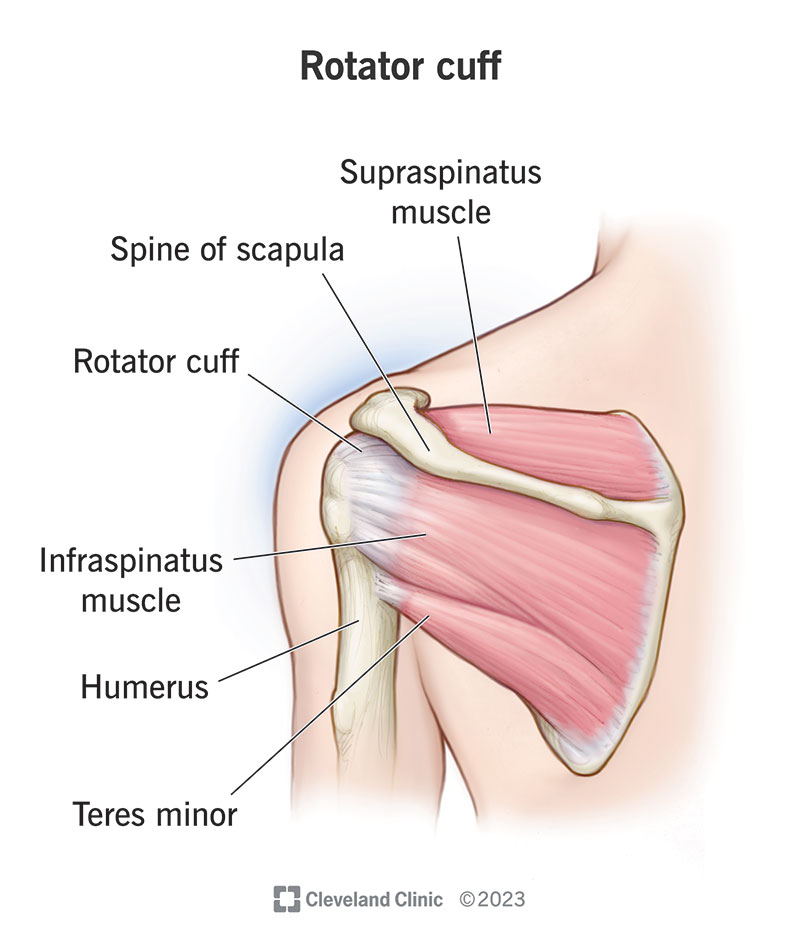The rotator cuff is a group of muscles and tendons that surrounds your shoulder. It holds your humerus (upper arm bone) in place in its socket in your scapula (shoulder blade). Rotator cuff injuries are common, especially among athletes who play contact sports. Visit a healthcare provider if you’re experiencing shoulder pain or arm weakness.
Advertisement
Cleveland Clinic is a non-profit academic medical center. Advertising on our site helps support our mission. We do not endorse non-Cleveland Clinic products or services. Policy

The rotator cuff is a group of muscles and tendons around your shoulder joint.
Advertisement
Cleveland Clinic is a non-profit academic medical center. Advertising on our site helps support our mission. We do not endorse non-Cleveland Clinic products or services. Policy
There’s one rotator cuff surrounding each of your shoulders. It connects your shoulder blade (scapula) to your upper arm bone (humerus). You use your rotator cuff to raise your arm overhead and to rotate your arm toward and away from your body.
Rotator cuff injuries are common, especially among athletes. Visit a healthcare provider if you’re experiencing shoulder pain, arm weakness or can’t move your shoulder without pain.
Your rotator cuff keeps your shoulder and upper arm stable when you move and use them. You can probably guess based on its name, but it helps you turn and rotate your shoulder.
The muscles and tendons in your rotator cuff surround your shoulder joint and hold the bones together. Your shoulder is a ball-and-socket joint. The ball-shaped upper end of your humerus (its head) fits into a socket in your scapula — sort of like a golf ball sitting on a tee.
The rotator cuff sits in a small space between your humerus and the upper part of your shoulder blade. It surrounds your shoulder and covers the head of your humerus.
The rotator cuff is made of four shoulder muscles:
Advertisement
Tendons connect the muscles in your rotator cuff to the bones around them. Tendons are like levers that move your bones as your muscles contract and expand. When you contract (squeeze) muscles in your rotator cuff, tendons pull the attached bones to move your shoulder and upper arm.
Rotator cuff injuries are common because you use them so often for so many activities throughout your day. Injuries can happen suddenly or build up over time. Rotator cuff damage is a common sports injury.
The most common rotator cuff injuries include:
Rotator cuff tears cause shoulder pain. You may feel a dull ache deep within your shoulder, or the pain may feel sharp and stabbing. Sudden tears from traumas cause immediate, intense shoulder pain and arm weakness.
Visit a healthcare provider if you’re experiencing shoulder pain that doesn’t get better in a few days. Go to the emergency room if you can’t move your shoulder or experience trauma.
A healthcare provider will diagnose a rotator cuff injury with a physical exam and some imaging tests. They’ll examine your shoulder and ask about your symptoms. Tell them when you first noticed pain, and if any activities make your symptoms feel better or worse.
You might need a few tests, including:
Which treatments you’ll need depends on which injury you have and its severity. Your provider will suggest treatments to relieve pain and help your rotator cuff heal, including:
Advertisement
The best way to prevent rotator cuff injuries is to avoid overusing your shoulders:
Rest and avoiding physical activities can help your rotator cuff heal, but you should always get injuries examined and diagnosed by a healthcare provider. Don’t ignore symptoms like pain, weakness or a reduced range of motion (how far you can move your shoulder).
Continuing to use your shoulder or putting more stress on your rotator cuff can make minor injuries worse.
Your rotator cuff is exactly what it sounds like — a cuff of muscles and tendons that helps your shoulder and arm rotate. It also holds the bones in your shoulder together and helps you move your arms and lift them overhead.
Rotator cuff tears are common in professional athletes. But you don’t need to be a big-league pitcher or superstar quarterback to injure your rotator cuff. Injuries can happen all at once or build up over time with repeated wear and tear.
Advertisement
Visit a healthcare provider if you’re experiencing shoulder pain that doesn’t get better after a few days of rest and at-home treatments. They’ll diagnose the injury and suggest ways to help your rotator cuff heal.
Advertisement
From sudden injuries to chronic conditions, Cleveland Clinic’s orthopaedic providers can guide you through testing, treatment and beyond.

Last reviewed on 12/22/2023.
Learn more about the Health Library and our editorial process.